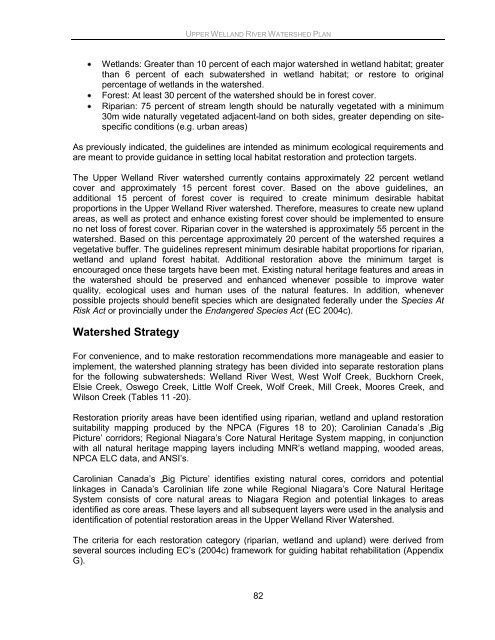Upper Welland River Watershed Plan - Niagara Peninsula ...
Upper Welland River Watershed Plan - Niagara Peninsula ...
Upper Welland River Watershed Plan - Niagara Peninsula ...
Create successful ePaper yourself
Turn your PDF publications into a flip-book with our unique Google optimized e-Paper software.
UPPER WELLAND RIVER WATERSHED PLANWetlands: Greater than 10 percent of each major watershed in wetland habitat; greaterthan 6 percent of each subwatershed in wetland habitat; or restore to originalpercentage of wetlands in the watershed.Forest: At least 30 percent of the watershed should be in forest cover.Riparian: 75 percent of stream length should be naturally vegetated with a minimum30m wide naturally vegetated adjacent-land on both sides, greater depending on sitespecificconditions (e.g. urban areas)As previously indicated, the guidelines are intended as minimum ecological requirements andare meant to provide guidance in setting local habitat restoration and protection targets.The <strong>Upper</strong> <strong>Welland</strong> <strong>River</strong> watershed currently contains approximately 22 percent wetlandcover and approximately 15 percent forest cover. Based on the above guidelines, anadditional 15 percent of forest cover is required to create minimum desirable habitatproportions in the <strong>Upper</strong> <strong>Welland</strong> <strong>River</strong> watershed. Therefore, measures to create new uplandareas, as well as protect and enhance existing forest cover should be implemented to ensureno net loss of forest cover. Riparian cover in the watershed is approximately 55 percent in thewatershed. Based on this percentage approximately 20 percent of the watershed requires avegetative buffer. The guidelines represent minimum desirable habitat proportions for riparian,wetland and upland forest habitat. Additional restoration above the minimum target isencouraged once these targets have been met. Existing natural heritage features and areas inthe watershed should be preserved and enhanced whenever possible to improve waterquality, ecological uses and human uses of the natural features. In addition, wheneverpossible projects should benefit species which are designated federally under the Species AtRisk Act or provincially under the Endangered Species Act (EC 2004c).<strong>Watershed</strong> StrategyFor convenience, and to make restoration recommendations more manageable and easier toimplement, the watershed planning strategy has been divided into separate restoration plansfor the following subwatersheds: <strong>Welland</strong> <strong>River</strong> West, West Wolf Creek, Buckhorn Creek,Elsie Creek, Oswego Creek, Little Wolf Creek, Wolf Creek, Mill Creek, Moores Creek, andWilson Creek (Tables 11 -20).Restoration priority areas have been identified using riparian, wetland and upland restorationsuitability mapping produced by the NPCA (Figures 18 to 20); Carolinian Canada‟s „BigPicture‟ corridors; Regional <strong>Niagara</strong>‟s Core Natural Heritage System mapping, in conjunctionwith all natural heritage mapping layers including MNR‟s wetland mapping, wooded areas,NPCA ELC data, and ANSI‟s.Carolinian Canada‟s „Big Picture‟ identifies existing natural cores, corridors and potentiallinkages in Canada‟s Carolinian life zone while Regional <strong>Niagara</strong>‟s Core Natural HeritageSystem consists of core natural areas to <strong>Niagara</strong> Region and potential linkages to areasidentified as core areas. These layers and all subsequent layers were used in the analysis andidentification of potential restoration areas in the <strong>Upper</strong> <strong>Welland</strong> <strong>River</strong> <strong>Watershed</strong>.The criteria for each restoration category (riparian, wetland and upland) were derived fromseveral sources including EC‟s (2004c) framework for guiding habitat rehabilitation (AppendixG).82
















